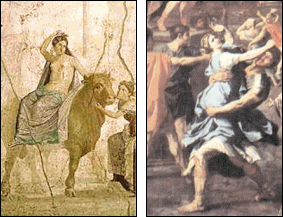|
Prohibited Sexual Behavior and Sexual Violence
|
|
Sexual Violence: Rape: Historical Notes
|
|
In ancient Greek mythology, the supreme god Zeus, on different occasions, became infatuated with two mortals - the princess Europa and the boy Ganymede. After abducting and making love to them, he rewarded them generously, installing Europa as the queen of Crete and appointing Ganymede his cup bearer.
The founding myth of ancient Rome tells of rape on a large scale: Since the new city did not have enough females to ensure its continued population growth, it invited the neighboring Sabines to a religious celebration. In the midst of the festivities, the hosts suddenly attacked their guests and abducted and raped the Sabine women. Forced to marry their rapists, the women then gave birth to the much needed new generation of Roman citizens.
These ancient myths already hint at two main motives of rape: Spontaneous sexual impulse (Zeus) and premeditated subjugation (the city of Rome). These motives are often intermingled, and they can be traced through all of human history to the present day.
 |
Rape in Greek and Roman Mythology
(Left) “The Rape of Europa”: In order to get close to the princess, Zeus assumed the shape of a bull. When she climbed his back, he abducted her. Detail of a wall painting in Pompeii, 1st century AD
(For the purpose of abducting Ganymede, Zeus assumed the shape of an eagle.)
(Right) “The Rape of the Sabine Women“. Detail of a painting by Nicolas Poussin (1594–1665) |